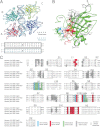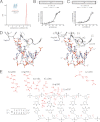Crystal structures of the DNA-binding domain tetramer of the p53 tumor suppressor family member p73 bound to different full-site response elements
- PMID: 23243311
- PMCID: PMC3576079
- DOI: 10.1074/jbc.M112.408039
Crystal structures of the DNA-binding domain tetramer of the p53 tumor suppressor family member p73 bound to different full-site response elements
Abstract
How cells choose between developmental pathways remains a fundamental biological question. In the case of the p53 protein family, its three transcription factors (p73, p63, and p53) each trigger a gene expression pattern that leads to specific cellular pathways. At the same time, these transcription factors recognize the same response element (RE) consensus sequences, and their transactivation of target genes overlaps. We aimed to understand target gene selectivity at the molecular level by determining the crystal structures of the p73 DNA-binding domain (DBD) in complex with full-site REs that vary in sequence. We report two structures of the p73 DBD bound as a tetramer to 20-bp full-site REs based on two distinct quarter-sites: GAACA and GAACC. Our study confirms that the DNA-binding residues are conserved within the p53 family, whereas the dimerization and tetramerization interfaces diverge. Moreover, a conserved lysine residue in loop L1 of the DBD senses the presence of guanines in positions 2 and 3 of the quarter-site RE, whereas a conserved arginine in loop 3 adapts to changes in position 5. Sequence variations in the RE elicit a p73 conformational response that might explain target gene specificity.
Figures




References
-
- Riley T., Sontag E., Chen P., Levine A. (2008) Transcriptional control of human p53-regulated genes. Nat. Rev. Mol. Cell Biol. 9, 402–412 - PubMed
-
- Menendez D., Inga A., Resnick M. A. (2009) The expanding universe of p53 targets. Nat. Rev. Cancer 9, 724–737 - PubMed
-
- Yang A., Walker N., Bronson R., Kaghad M., Oosterwegel M., Bonnin J., Vagner C., Bonnet H., Dikkes P., Sharpe A., McKeon F., Caput D. (2000) p73-deficient mice have neurological, pheromonal and inflammatory defects but lack spontaneous tumours. Nature 404, 99–103 - PubMed
-
- Mills A. A., Zheng B., Wang X.-J., Vogel H., Roop D. R., Bradley A. (1999) p63 is a p53 homologue required for limb and epidermal morphogenesis. Nature 398, 708–713 - PubMed
Publication types
MeSH terms
Substances
Associated data
- Actions
- Actions
Grants and funding
LinkOut - more resources
Full Text Sources
Other Literature Sources
Research Materials
Miscellaneous

